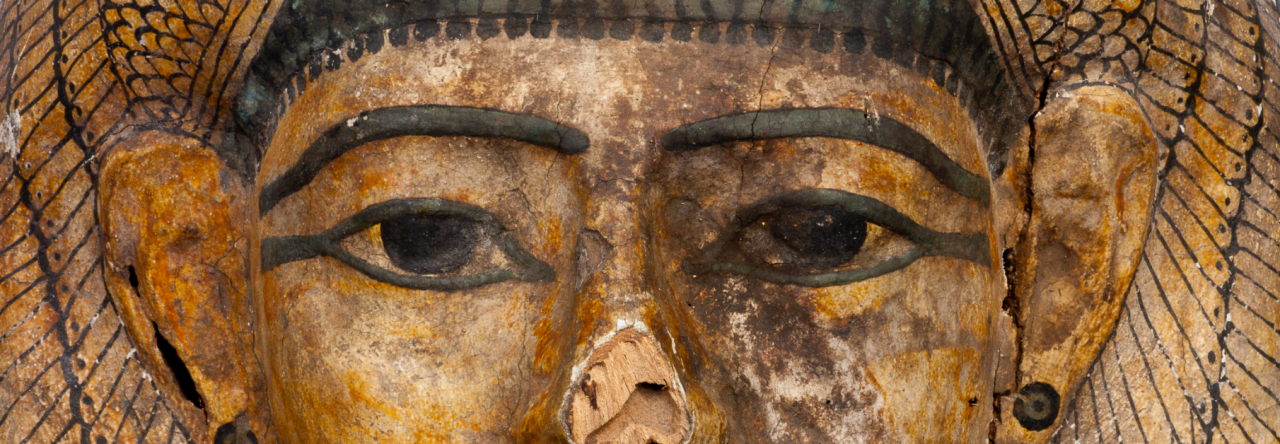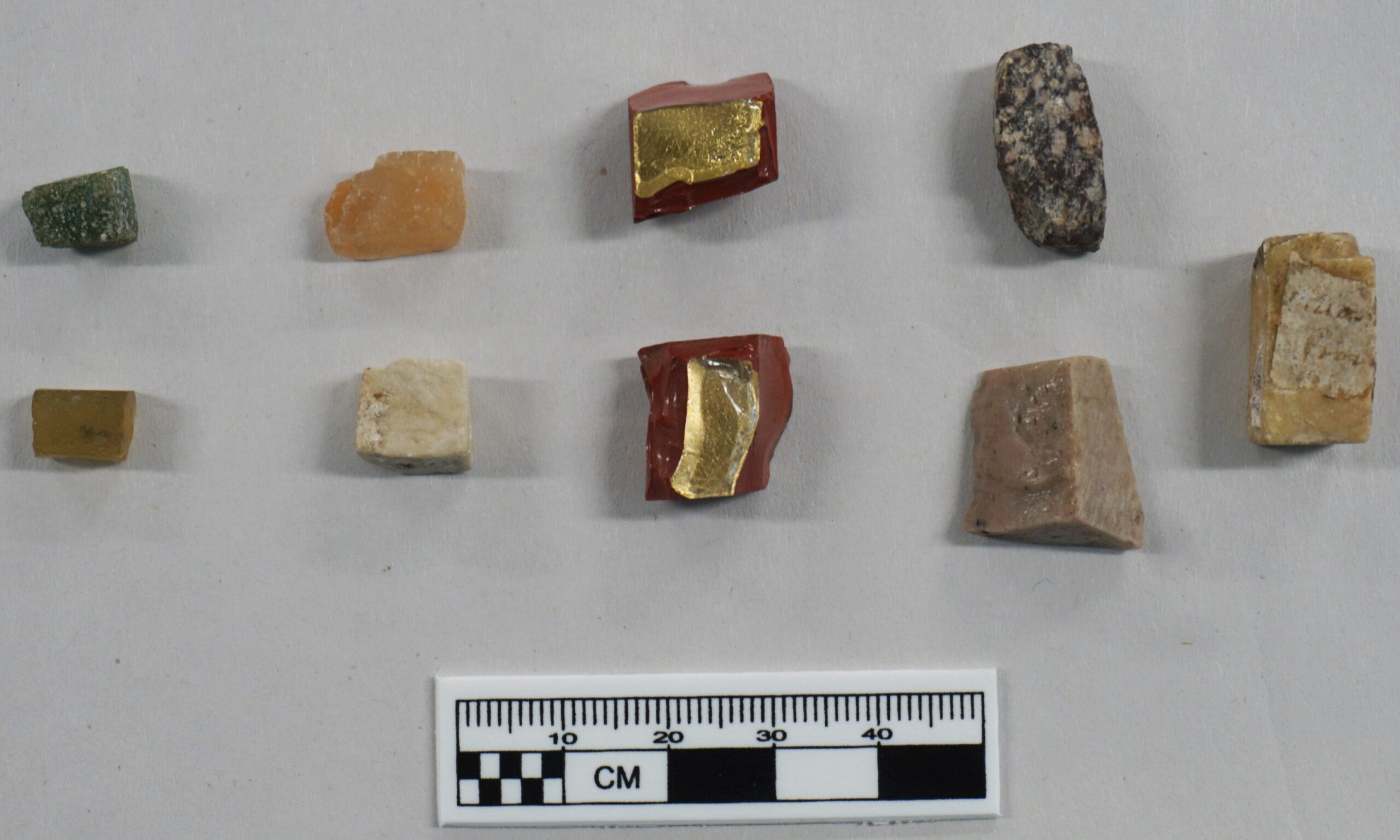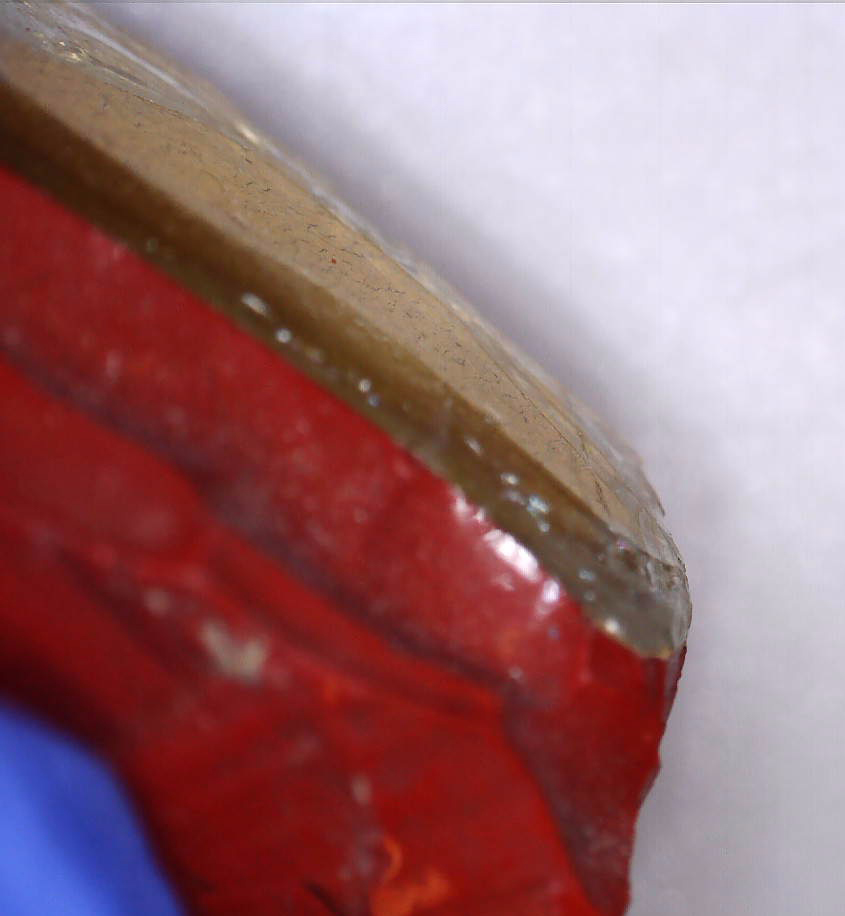AWG1901.01.01
Roman (Late Roman - Byzantine)
Material: Stone and glass
Dimensions: Red and Gold (1): 1.5cm long, max. width 1cm - Red and Gold (2): 1.5cm long, max. width 1.4cm - Cream: 2.9cm long, max. width 0.8cm - Black and White: 1.9cm long, max. width 1cm - Green: 0.9cm long, max. width 0.6cm - Light Pink: 1.8cm long, max. width 1.7cm - Peach: 1.2cm long, max. width 0.8cm - White: 1cm long, max. width 0.9cm - Gold Glass: 0.9cm long, max.width 0.6cm
Conservation: Several tesserae have remnants of mortar on the sides
Provenance: Unknown
Source/donor: Museum of Richmond College, probably donated by William Thomas Hundley, acquired 1900-1901
Research by: Paige Walworth (Maggie Walker Governor’s School, ’22)
Detailed description of form/shape:
A collection of tesserae of various materials, shapes, and colors. Each piece is roughly rectangular or cubical in shape. One tessera, a cream colored rectangular tessera (at the right of the group photo above), has faint remnants of a label on three sides and mortar on the other side. The white cube tessera also has faint remnants of mortar on several sides. The pieces are made from different materials, including various stones, glass, and glass paste with gold leaf.
Comparanda:
For an example of tesserae similar to the red with gold leaf, cf. Louvre inv. no. OA 7735/47 (Louvre Online Collections). For an example of green tesserae, cf. Louvre inv. no. AFI 2295/47 (Louvre Online Collections). For an example of a mosaic fragment using green tesserae, cf. Louvre inv. no. AFI 2295/17 (Louvre Online Collections)
Discussion:
Tesserae are stone and glass pieces used to form mosaics. Due to their fragility, glass tesserae were sparingly used in floor mosaics but were often found in mosaics used as wall decoration. Wall or vault mosaics were known as opus museum or musivium, while floor mosaics were known as opus tessellatum. Wall-mosaicists (musearius or musivarius) were paid 20 percent higher than floor mosaicists (tessellarius or tesserarius) as stipulated in Diocletian’s Price Edict, since there was a greater danger when crafting mosaics high up (Ling 7).
As described in Vitruvius’ On Architecture, Roman mosaics were composed of three preparatory layers. These included an initial layer of fine rubble (statumen), a no less than three-quarters foot thick layer of compacted mortar (rudus), and a layer not less than six inches thick of an aggregate of terracotta (nucleus). In many remaining mosaics, it is possible to see one or two preparatory layers of coarse mortar, only about 2 or 3 inches thick, with a fine layer of mortar in which the tesserae would be pressed (Ling 11).
Stone tesserae were made by sawing raw material in long sticks and then chipping the pieces in cubes with a hammer and chisel. Glass tesserae were formed from flat glass “cakes” that were chipped into individual pieces. Tesserae were likely stockpiled, as evident by buildings found with heaps of tesserae (Ling 13).
Two tesserae in the Ancient World Gallery Collection are made from red glass paste with a layer of gold leaf decoration under a layer of clear glass (see Louvre OA 7735/47). In an experimental study at the Bezalel Academy of Art and Design in Jerusalem, replica gold-glass tiles were made using the technique of sand casting and glass blowing. Gold foil was added to hot glass shaped in a square sand mold, and a thin layer of colorless glass was blown on top of the gold foil (Gorin-Rosen). The similar tesserae at the Louvre are from Samarra and are dated in the 9th century.
William Thomas Hundley possibly acquired these tesserae during his travels to Egypt, Palestine, Turkey, Greece, and other countries in 1900. The decayed paper label attached to one of the tesserae matches better-preserved white paper labels on some objects now in the Lora Robins Gallery that had been part of the Richmond College museum. Records describe Hundley acquiring mosaic pieces from the floors in the Palace of Titus in Rome, as well as small rocks and pebbles from other places he visited. These items were housed as of 1974 in the Rare Books Room in Boatwright Library, along with the limestone sphinx which is now in the Ancient World Gallery (Cherry). Therefore, it is likely that the tesserae in the Ancient World Gallery originally belonged to Hundley’s collection.
Bibliography:
Belis, Alexis. “Italy.” In Roman Mosaics in the J. Paul Getty Museum, by Alexis Belis.
Los Angeles: J. Paul Getty Museum, 2016. http://www.getty.edu/publications/romanmosaics/catalogue/italy/.
Cartwright, Mark. “Roman Mosaics.” World History Encyclopedia. June 14, 2013. https://www.worldhistory.org/article/498/roman-mosaics/
Cherry, Ann F. “An approximate record of the historical and artistic possessions of the University of Richmond as of October 1, 1974.” Typed card catalog index held in the University of Richmond Archives, Virginia Baptist Historical Society.
Gorin-Rosen, Yael. “Byzantine Gold Glass from Excavations in the Holy Land.” Journal of Glass Studies 57 (2015): 97–119. http://www.jstor.org/stable/24726950.
Ling, Roger. Ancient Mosaics. Princeton: Princeton University Press, 1998.
For more information on the gold foil technique, see:
Helary, Doriane. “Étude de couches dorées sur matières vitreuses : application aux
tesselles à feuille d’or et aux céramiques glaçurées à décors de lustres dorés.”
Sciences de l’ingénieur. École Nationale Supérieure des Mines de Paris, 2003. https://pastel.archives-ouvertes.fr/pastel-00001345/documen


